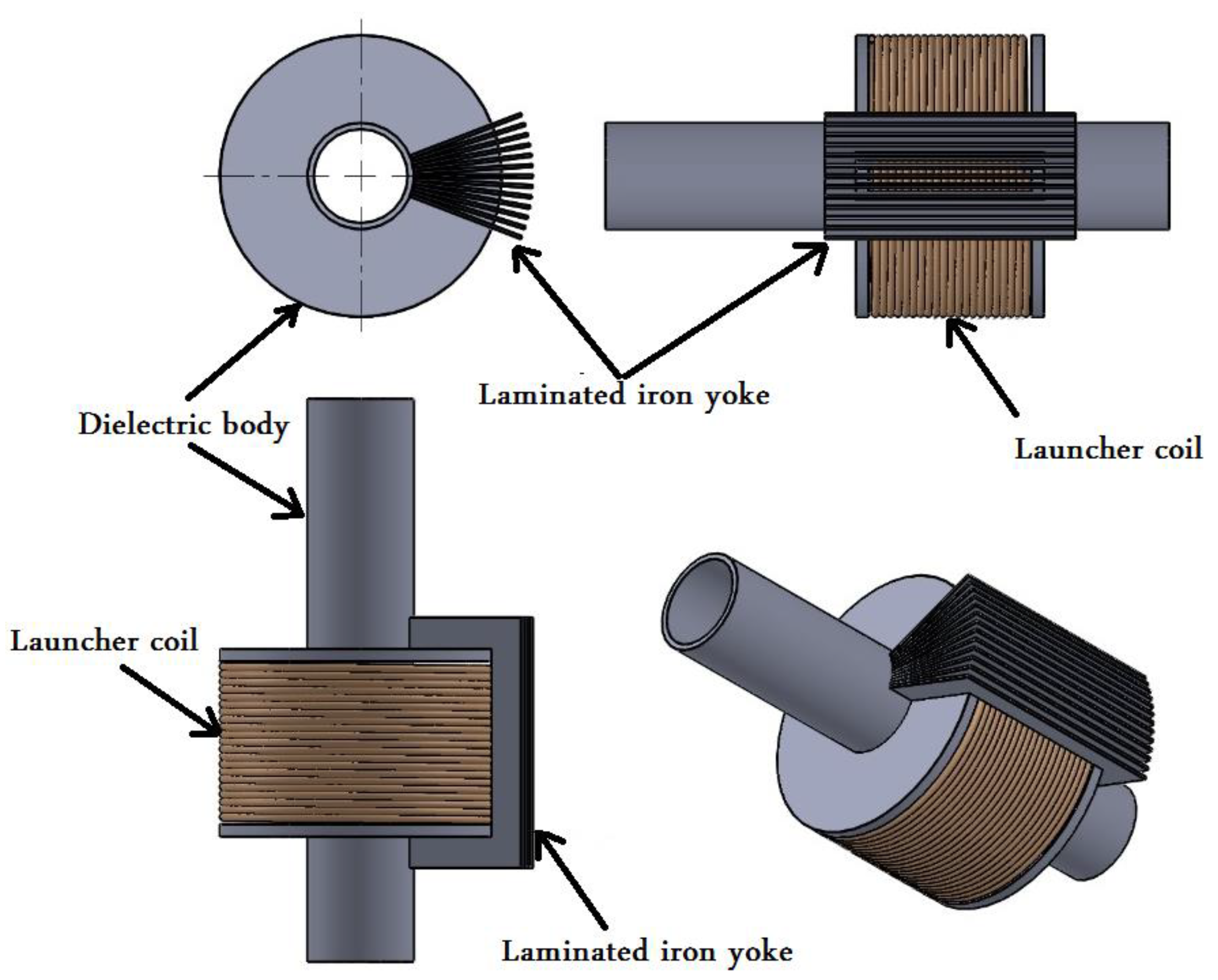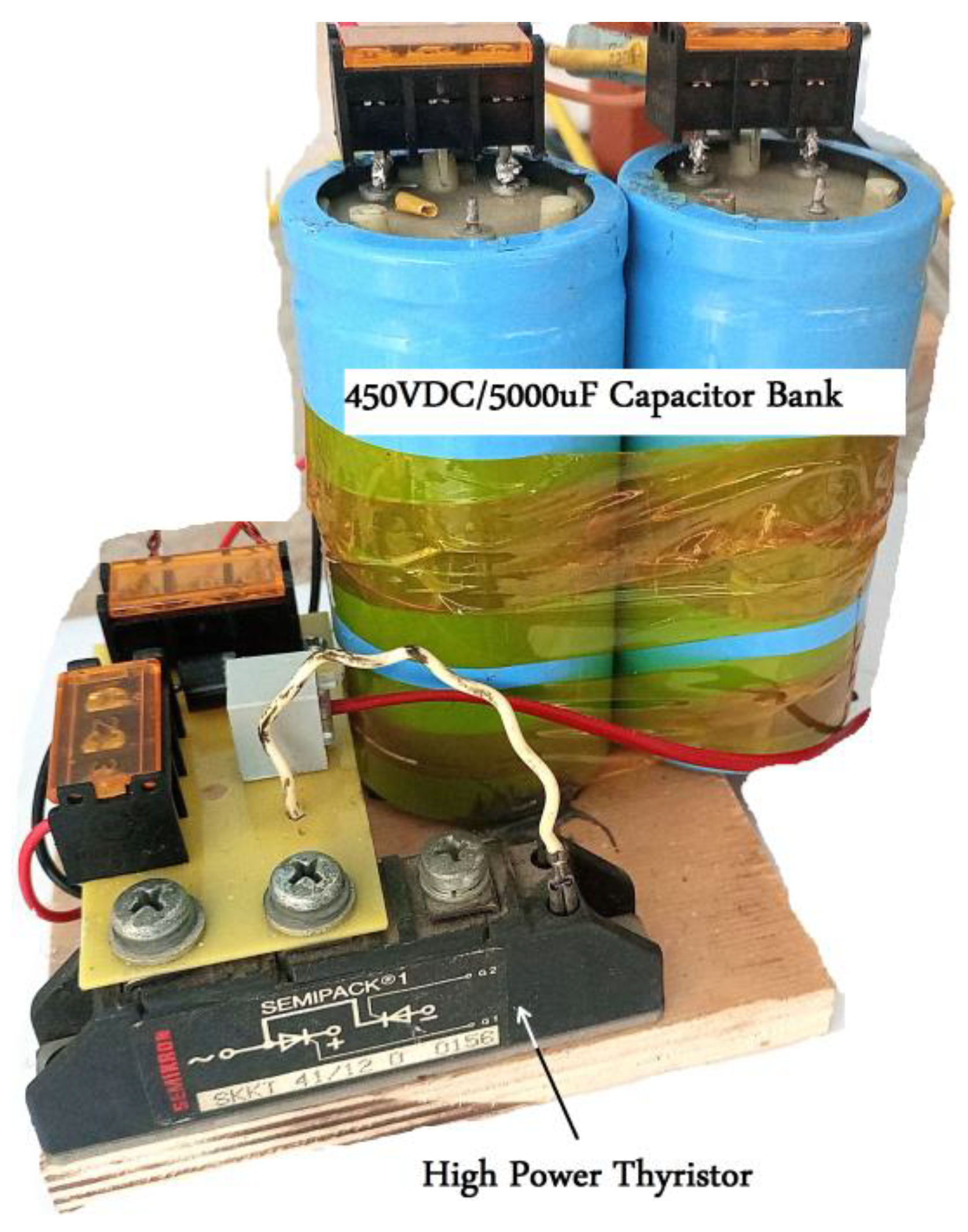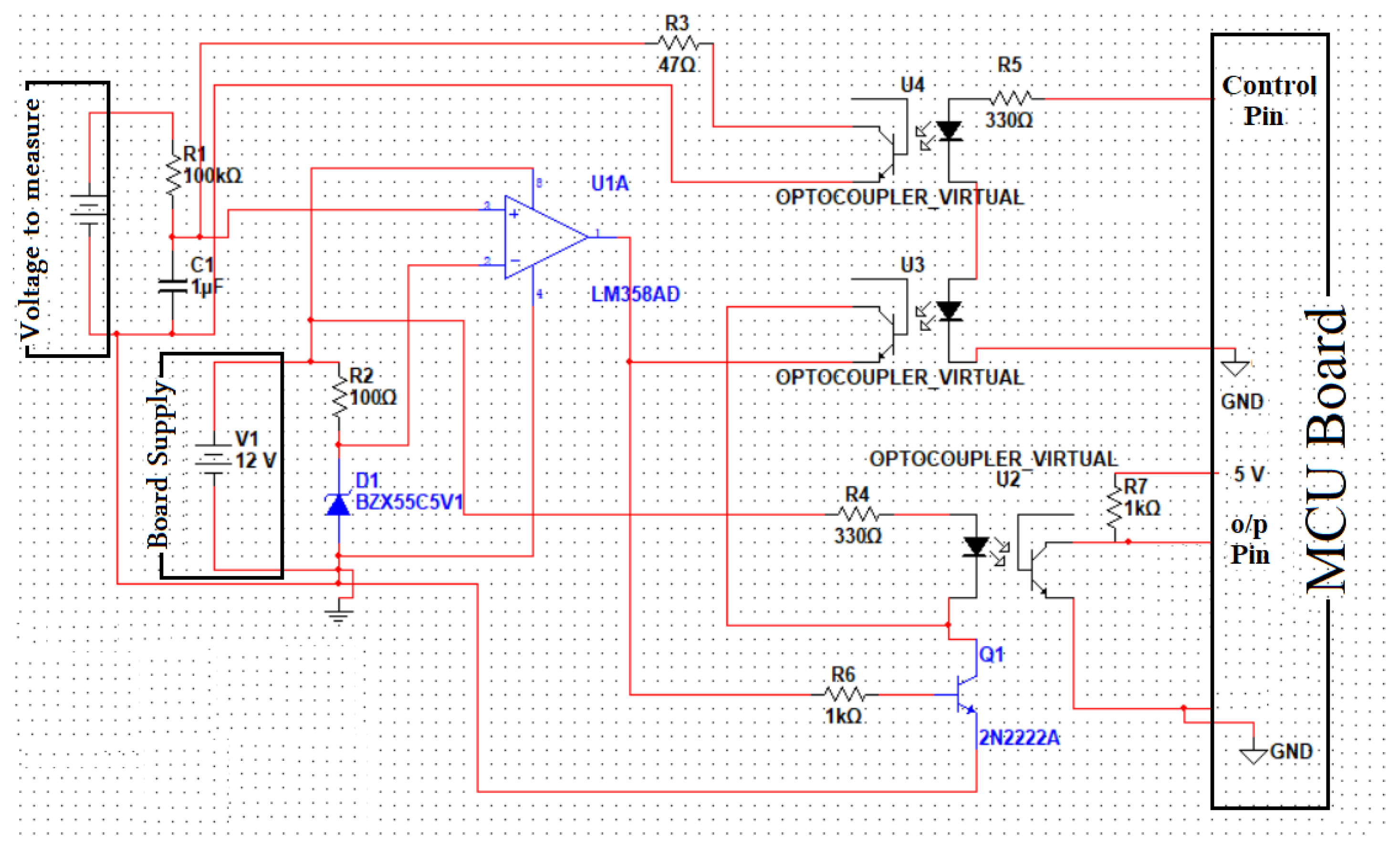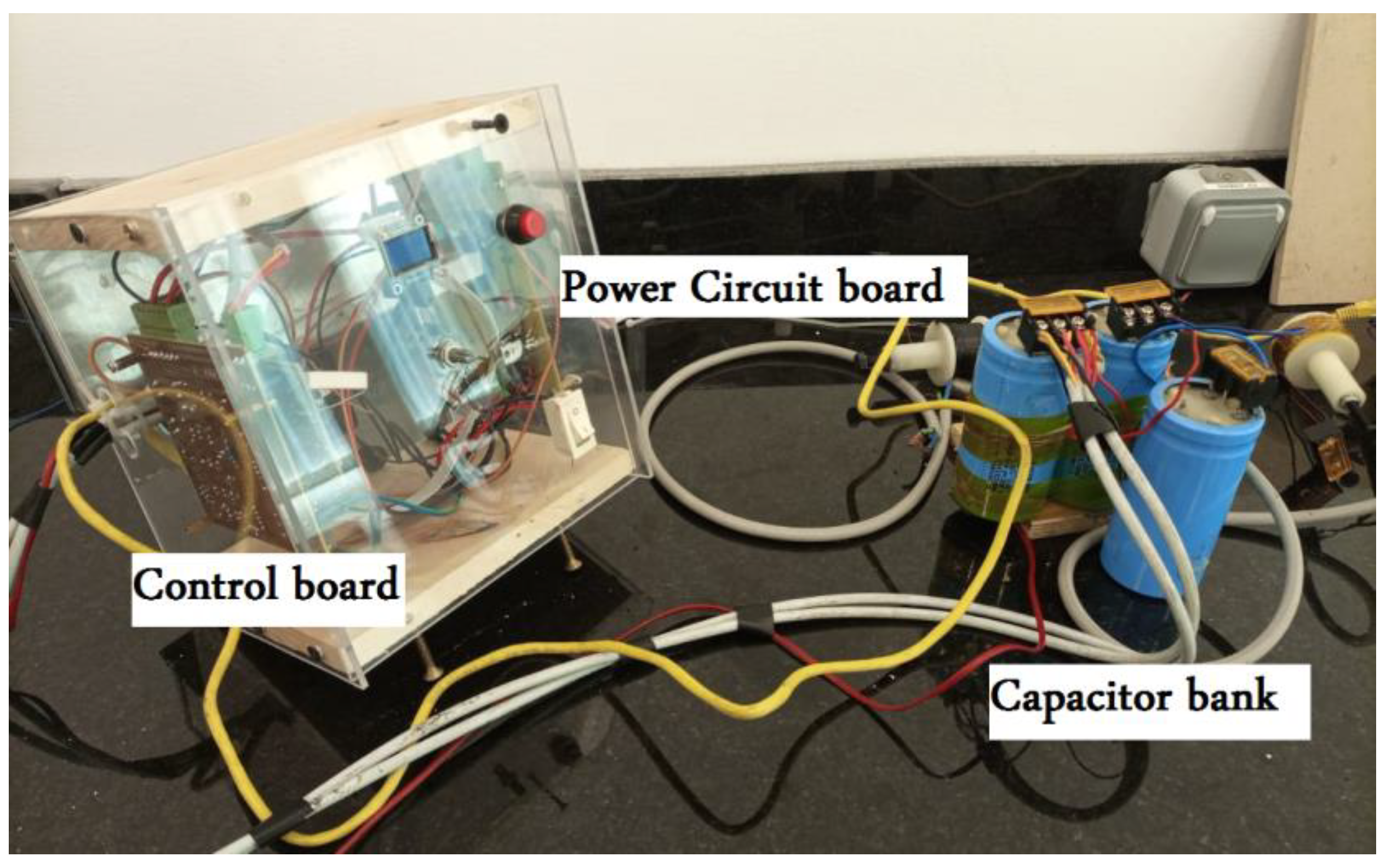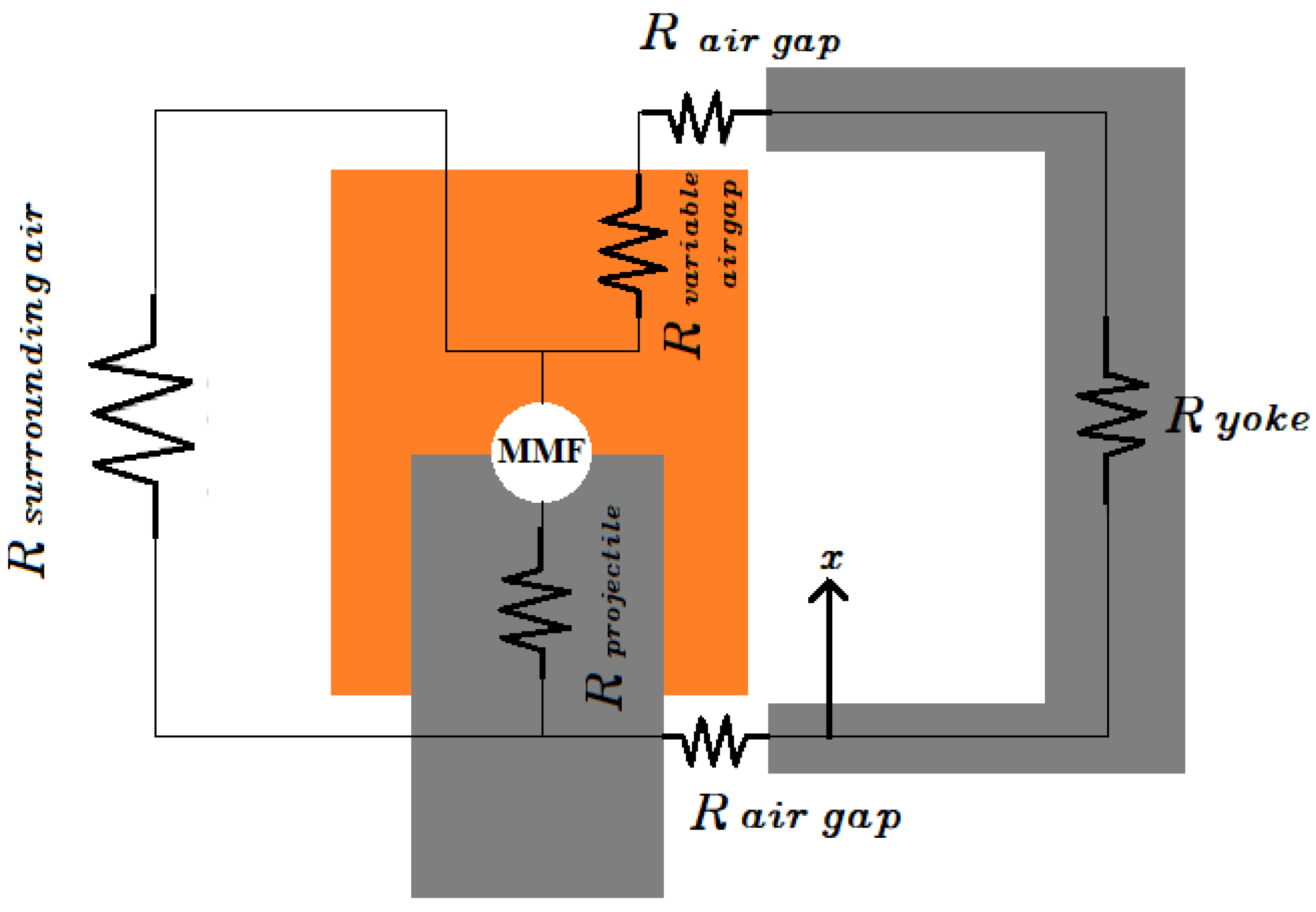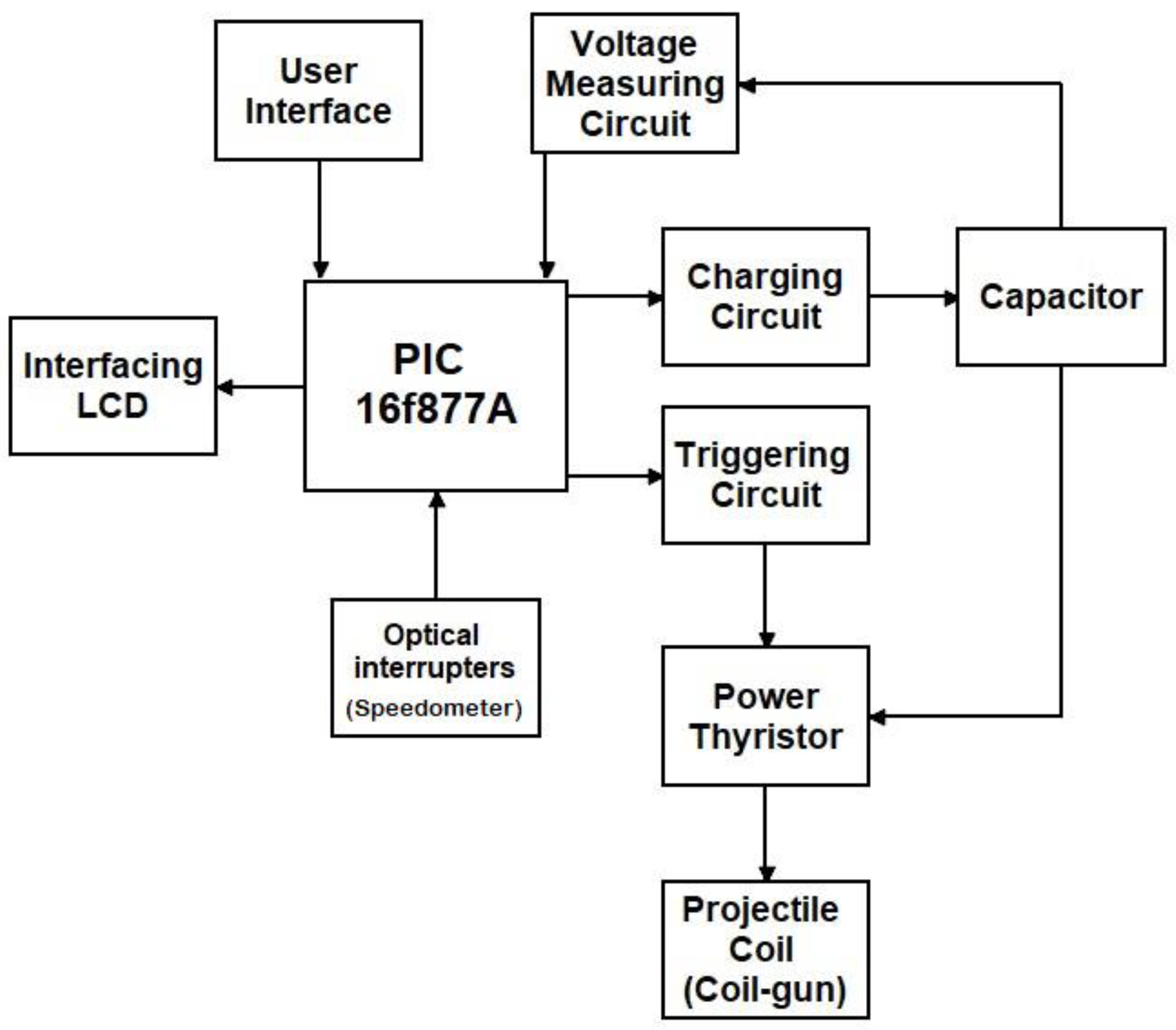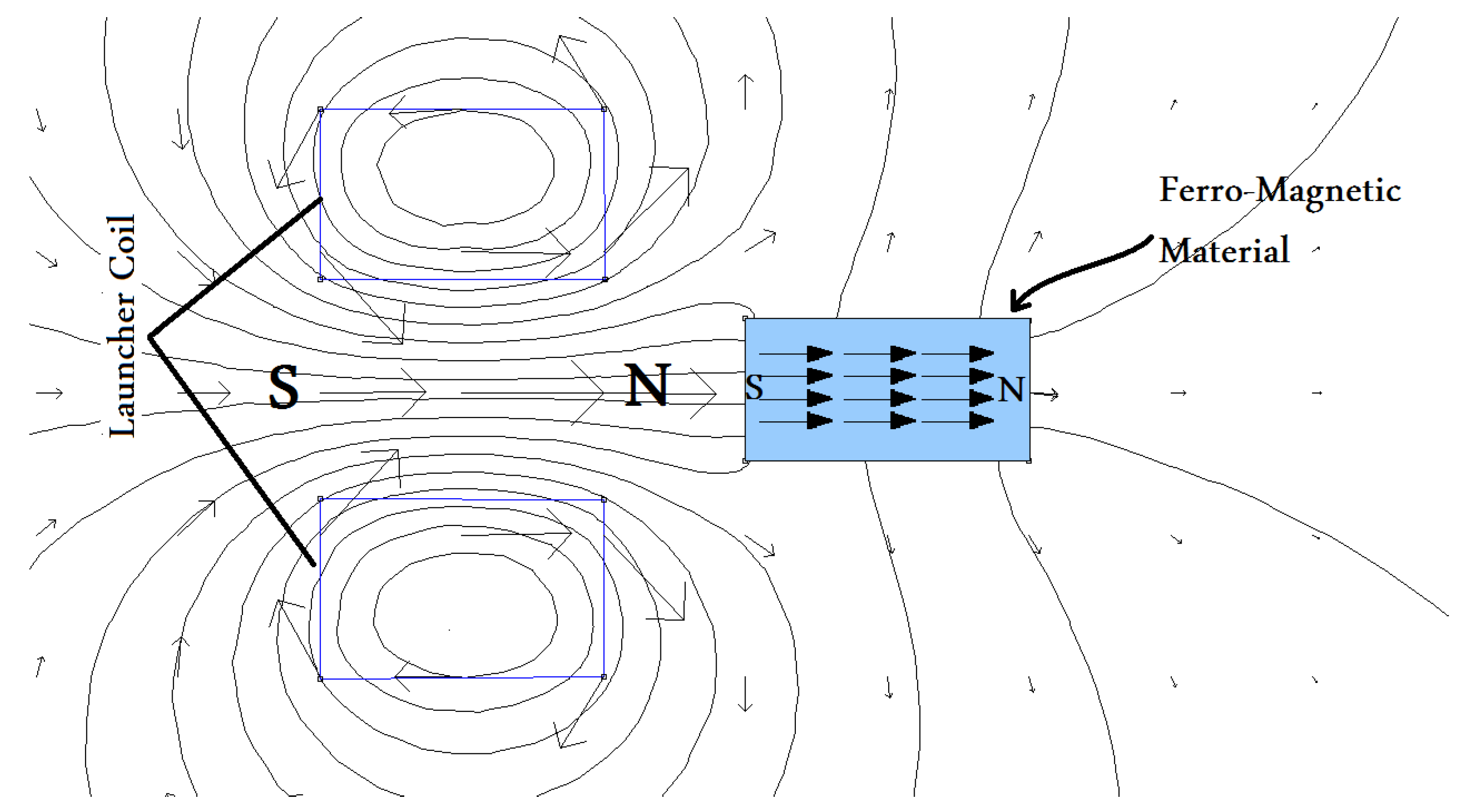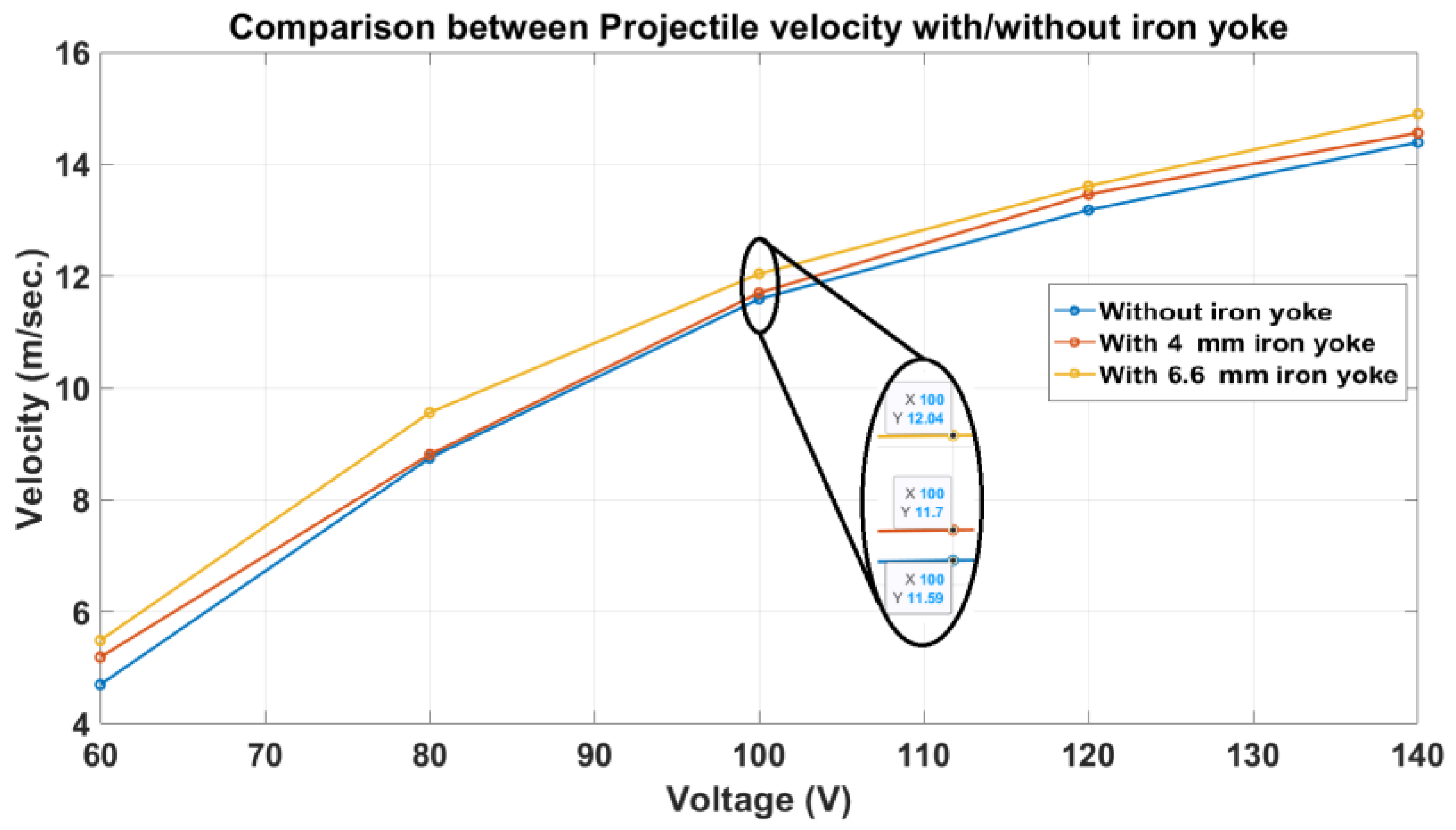1. Introduction
Nowadays, electromagnetism is a vital science in generating mechanical forces and torques to propel vehicles and satellites to space and transportation on Earth. It rapidly accelerates ferromagnetic projectiles using electrical energy converted to kinetic energy. Electromagnetic science has contributed to many applications, such as Earth-to-orbit (ETO) microsatellite systems [
1]; powerful launchers that can propel small satellites to settle at low Earth orbit [
2]; low-speed and high-speed trains, high-speed, long-range fire support naval guns, and direct satellite launch to space [
3]; launch of lunar liquid oxygen (LLOX) from the Moon to the stationary Lagrangian point L2 [
4]; and electromagnetic guns [
5,
6,
7,
8,
9,
10,
11,
12].
A coil-gun launcher is an obvious application for electromagnetic systems. Such an application is used to launch a ferromagnetic projectile with very high velocities for long distances, as described in [
13]. For coil guns only, accelerating stages can be cascaded to boost the projectile speed more and more. A distinctive advantage of the coil gun over other launchers is it can electromagnetically stop and recover the projectile before leaving the barrel. Moreover, the launching process results in no damage, therefore the equipment lasts for an endless time. In addition, the cost of this kind of gun is relatively low compared to traditional rockets as it is recyclable, never causes environmental pollution, and has low electricity consumption.
Space exploration, especially Moon exploration, requires improvement of launching capabilities. The Moon’s soil is rich in oxygen and metals used for refueling space rockets in space. To launch things (including extracted oxygen and metals) from the Moon to space, solar-based electromagnetic launchers may be the most appropriate solution [
14,
15]. This demand requires analysis and innovation of electromagnetic launchers (EMLs) which will be utilized for rocket launching from the Moon without fuel. In addition to Moon exploration, launching nanosatellites (CubeSat) from space vehicles is an important part of modern space exploration. Therefore, electromagnetic launcher development attracts great interest to meet space requirements. Even though the electromagnetic launcher has no restriction on the speed limit, experimental studies are performed with low launching speeds for security. Experiments demonstrated that the launching mass and energy are extendable [
16].
There are some drawbacks to this kind of launcher.
There are some limitations to achieve 100% efficiency:
High magnetic reluctance which limits the number of flux lines and makes the user increase the current passes through the coil to achieve a certain number of flux lines.
The current that passes through the coil is extremely high which requires high-power expensive electronic devices.
Low saturation flux density of all ferromagnetic materials used for projectile manufacturing is a huge challenge.
Launcher coil electrical resistance which consumes a considerable amount of energy.
Eddy current is produced inside the projectile due to the presence of changing flux which will generate a backward force.
Suck-back force limits the launcher efficiency, and it is a costly challenge.
This work deals with the first four challenges. It introduces a new design based on adding an iron yoke around the launcher coil to reduce the launcher’s magnetic reluctance to increase the number of flux lines at a lower current. This modification will lower the required rating of used electronic devices and save money. This iron yoke is manufactured from thin laminated silicon steel to reduce the eddy current and gain high saturation flux density.
The magnetic field, the main product of any coil, can only operate in the presence of magnetic dipoles, as in the case of ferromagnetic materials. The ferromagnetic material has a massive array of magnetic dipoles or any material of higher magnetic susceptibility. The authors of [
13,
18] demonstrated that magnetic forces could theoretically work according to classical electromagnetism on specific types of materials consisting of intrinsic and permanent primary dipole moments. Here, this theoretical claim has been proven experimentally in the proposed work. This theory and the experiments confirm that the projectile must be made of ferromagnetic materials that contain many magnetic dipoles to provide higher velocity and even motion, in contrast to diamagnetic and paramagnetic materials. Many researchers, as in [
8,
19,
20], assumed that the effect of mutual inductance between the solenoid and the projectile, which is considered a one-turn coil according to their theoretical claim, is the reason for the projectile propulsion. The latter claim may come true under some circumstances but not in the case of a solid cylindrical projectile.
The proposed research considers the single-coil gun as a building block for a substantial electromagnetic launcher. So, this work focuses on enhancing a single-coil gun to reach an optimal design. A launcher with an exit velocity of 54.3 m/s and efficiency of 0.32% was developed in [
7]. In [
21], a 2000-joule two-coil launcher was modified to accelerate a 5-g projectile to 54.84 m/s with an efficiency of about 0.375%. In [
16], seven cascaded coils are used to reach 130 m/sec exit speed with an efficiency of 1.32% without focusing on the enhancement of a single-coil launcher before cascading many coils. And in [
22], a three-winding launcher was developed to accelerate a 7 cm long projectile to 15.66 m/s with efficiency of 2.04%.
As the magnetic force is highly related to the magnetic circuit reluctance, as shown in [
23], we theoretically and experimentally study the effect of decreasing the magnetic circuit reluctance on the projectile velocity by introducing a new design with a soft iron laminated yoke around the coil. The design depends on decreasing the air gap between the two ends of the projectile. This produces higher magnetic flux density and boosts the number of flux lines. This may cause saturation of the iron yoke earlier than usual, therefore high saturation flux density material is used to avoid that. The presence of an iron yoke around the coil makes a huge change in its inductance according to the armature position which results in an enormous force according to Equation (1). This equation shows that the force is directly proportional to the ratio between the change in the inductance to the change in position. And because the change in position is approximately constant, the force increases as the change in inductance increases. Moreover, referring to previous work [
24], the coil is wound in a double circuit to reduce copper losses and increase the efficiency compared to the case of using a single wire. In addition, this configuration extends the launcher voltage range.
Researchers in [
25] concluded that the armature (projectile) material should be have high saturation flux density as an essential requirement. They also demonstrated the eddy current problem, which negatively affects the device’s efficiency because it consumes a significant amount of energy. The resistivity of the ejected material is instrumental in reducing the eddy current. Researchers in [
25] changed the projectile’s shape and material to drop the projectile conductivity because lower resistance would result in higher eddy currents and more significant Lorentz force. As a result, highly conductive materials will reduce the resultant propulsion force. This problem has been restricted by the laminating method. In this paper, the projectile is solid and made of medium carbon steel material, to preserve the projectile strength while hitting the obstacles. However, the saturation of this material is a problem that led to a poor increase in the projectile velocity at higher voltages. The iron yoke developed in this work is made of laminated soft iron sheets.
The authors of [
26] found that improving the discharge circuit of the launcher coil leads to a reduction in the suck-back force. The suck-back force is a reverse force that appears when the projectile crosses the coil’s first half. They used an IGBT switch to control the turning on and turning off time. Suck-back force is the leading cause of magnetic projectile damping when the projectile centerline coincides with the launcher coil centerline. There is a challenge in introducing new discharging circuits. In [
24], a previous work of the same authors of this work, the effect of suck-back force was addressed by decreasing the number of magnetic flux lines that pass through the projectile after reaching the second half of the coil by changing the shape of the coil into a conical shape.
The application targeted by this work is micro- and nanosatellite launching. But this kind of launcher is limited in its efficiency which may force an increase in the number of stages to achieve the Earth escape velocity as in the case of the Sandia launcher [
4]. A flying launchpad could be used to use the merits of this launcher and decrease the number of stages. The flying launchpad transmits the launcher to the required height to reduce the needed energy to propel the satellite with its available capabilities. The velocity of the launcher introduced in this paper is extendable to any required velocity. But to prove the concept of improving the launcher by adding an iron yoke and verifying security and safety constraints, the speed in all experiments was limited as in this work. Heat generated through the launching process can be estimated by the analysis that was performed in [
27].
All mentioned references use higher input voltage or the number of stages to raise the output velocity which requires much energy. In addition, these methods do not contribute to increasing efficiency further. But no one has used the same input voltage and tried to decrease the magnetic reluctance (by adding an iron yoke) and save a huge amount of energy.
The research work in this paper mainly contributes to a new design idea for the launcher. To demonstrate this idea, the main parts of the launcher must be illustrated. This launcher consists of four main parts:
Launcher coil: this part generates the needed magnetic flux lines and has many parameters to control the number of these flux lines.
Capacitor bank: this component stores a large amount of energy to discharge in the launcher coil to generate a time-changing current.
Launching circuit: this circuit controls the current that passes from the capacitor to the launching coil by using a high-current thyristor and its firing circuit.
Control circuit: this circuit is responsible for managing the charging time and firing signal to the thyristor and measuring the exit velocity.
The modifications are to add an iron yoke around the launcher coil and carry this launcher on a flying launchpad. This design idea mainly contributes to:
Launching a satellite from a flying launchpad may reduce many stresses on the satellite while launching. In addition, less money is required compared to building a massive launchpad on the ground to launch the satellites with the escape velocity of the Earth. Moreover, safety is ensured because the flying launchpad can safely launch satellites from anywhere. Finally, the percentage of success increases with the flying launchpad because it is near the low Earth orbit.
Adding an iron yoke significantly increases the number of magnetic flux lines by reducing the magnetic reluctance of the launcher coil which was achieved by adding a laminated iron yoke around the launcher coil instead of increasing the input voltage of the single stage as in [
7,
12,
16,
17,
26].
Magnetic flux lines are strengthened, resulting in an increased number of aligned magnetic dipole moments. The increasing number of aligned magnetic dipole moments results in a higher attractive force.
The operating voltage required to achieve a pre-defined velocity is reduced. In other words, the voltage an ordinary launcher uses for the same speed is higher than the voltage a modified launcher needs. This may lead to a reduction of the required rated voltage of launching devices and lower the cost.
Adding an iron yoke makes the magnetic path defined. The magnetic path length directly affects the coil inductance. Consequently, the deduction of a mathematical model for the system becomes smoother than before.
There are some limitations that could potentially limit the use of an iron yoke:
Increase in the launcher weight.
A velocity limitation due to low saturation flux density in the case of poor-permeability ferromagnetic materials.
Energy loss due to eddy currents produced in the case of high-conductivity ferromagnetic materials.
The rest of the paper is organized as follows:
Section 2 shows the application of the developed launcher.
Section 3 describes a detailed explanation of the design of the launcher system modules.
Section 4 gives the modified system equations.
Section 5 describes the operation algorithm of the launcher. Then, the experimental work is carried out and a discussion of the results is presented by comparing the modified launcher with the system used in the literature [
7,
16] in
Section 6. Future work suggestions are presented in
Section 8. Finally,
Section 9 concludes this paper.

